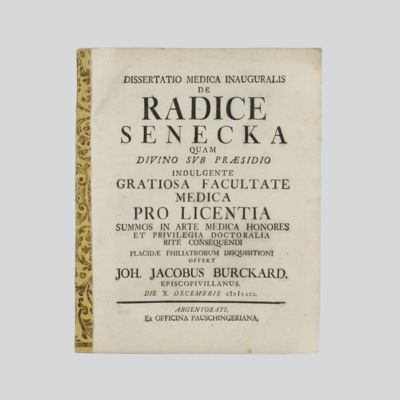Burckard, J. J. [Burckhart]
Dissertatio medica inauguralis de Radice Senecka.
Argentorati [Strasbourg], Pauschinger, 1705. Small 4to (20.1 x 16.1 cm). 20 pp. Contemporary marbled paper spine cover.
A rare thesis written by the German medical doctor and innkeeper Johann Jacob Burckhart (1667-1723). It deals with the pharmaceutical properties of a North American plant, Senega officinalis Spach, known as Seneca or senega snakeroot, rattlesnake root, or mountain flax. "This plant had many uses among Native Americans. The Cherokee used it as an expectorant and a diuretic, and for inflammation, croup, and common cold. The Chippewa used preparations of the root to treat convulsions and bleeding wounds. The Cree chewed the root for sore throat and toothache. According to Canadian botanist Frère Marie-Victorin, the Seneca may have been inspired to use the root to treat snakebite by its resemblance to the tail of a rattlesnake. The root was exported to Europe in the 1700s and was sold widely by pharmacists into the 1800s. It was marketed as a treatment for pneumonia. It is still in use as an herbal remedy. It is ground and made into patent medicines, mainly remedies for respiratory complaints. It is added to cough syrups, teas, lozenges, and gargles. It is toxic in large amounts, and overdose causes such symptoms as diarrhoea and 'violent vomiting'. The powdered root can be sternutatory (sneeze-inducing)" (Wikipedia). A very good, clean copy.




